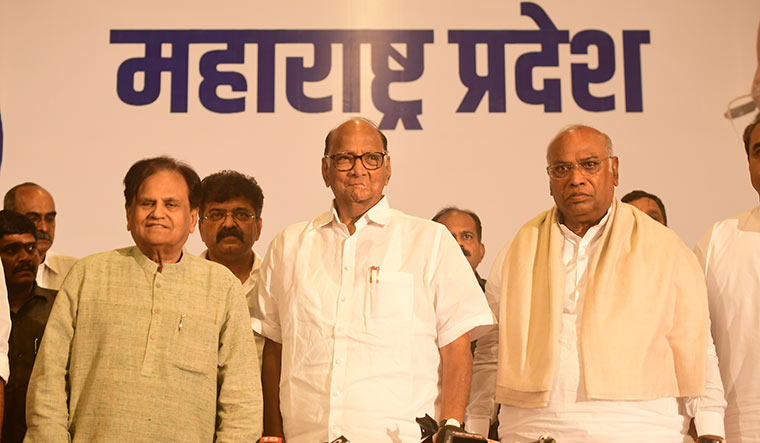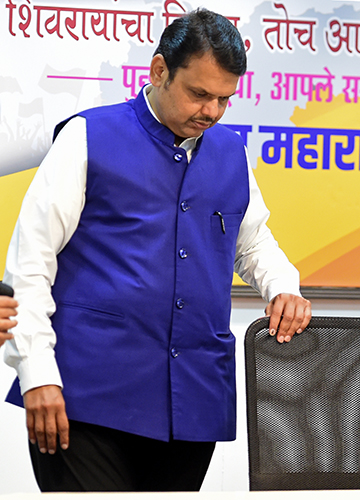ON NOVEMBER 10, while addressing Shiv Sena legislators at The Retreat, a seaside resort on Mumbai’s Madh Island, party chairperson Uddhav Thackeray said Shiv Sena had, so far, been the bearer of the palanquin in which others sat. This time, he said, the party would occupy the palanquin. “I will ensure that the next chief minister of Maharashtra will be a Shiv Sainik,” he said to a huge round of applause.
This was a promise he had made his father and Shiv Sena founder Balasaheb Thackeray. And, since October 24, when the state election results were announced, Thackeray had been treading cautiously to realise this promise. In fact, he was so determined to do so that he even ignored phone calls by outgoing chief minister Devendra Fadnavis. The BJP, with 105 seats, had refused to share the chief ministership on a rotational basis.
Counselled by Sanjay Raut, editor of party mouthpiece Saamana, Uddhav had decided to leave the National Democratic Alliance on the same day. The events of the following day, however, took the wind out of the Sena’s sail. When Maharashtra Governor B.S. Koshyari asked whether the Sena, which had 56 seats, could form the government, the party swung into action. Early on November 11, Union Minister Arvind Sawant tweeted that he was resigning. Said Raut: “Our alliance with the BJP is just a formality now. They are willing to sit in the opposition, but are not willing to share power as decided before the Lok Sabha elections. They can have an alliance with Mehbooba Mufti (in Jammu and Kashmir), but will not give us what was agreed upon. This is the BJP’s arrogance.”
A Sena insider said the BJP leadership had not even congratulated Uddhav’s son, Aaditya, on his win from Worli. “Leaders from other parties called or sent messages, but no one from the BJP did so,” said the source. “Some basic courtesies have to be observed; they help bring down tensions. Aaditya is the first Thackeray ever to contest and get elected.”
On the same day, top leaders of the Nationalist Congress Party, which had won 54 seats, met in Mumbai and in principle decided to support a Shiv Sena-led government. The catch: The Congress, with 44 seats, also had to support it. When the Sena leadership heard about this, Uddhav and Aaditya went to meet NCP president Sharad Pawar. Sena MP Anil Desai and party secretary Milind Narvekar rushed to Delhi to meet senior Congress leader Ahmed Patel. Uddhav then called Congress president Sonia Gandhi and the two spoke for about ten minutes. Later, when Sonia spoke with Congress legislators from Maharashtra via video conferencing, they said the party should support the Sena to keep the BJP out of power.
But, as the 7.30pm deadline set by Koshyari neared, the Sena had not received letters of support from the Congress and the NCP. At about 7pm, Sena leaders Aaditya Thackeray, Subhash Desai and Eknath Shinde reached the Raj Bhavan and submitted a list of 64 legislators (who had agreed to support it) and asked Koshyari for more time. He refused. “The BJP got 72 hours to form government,” said a Sena leader. “We got only 24. We have been unfairly treated. We are serious about providing a stable government.”
The NCP blamed the Congress for dragging its feet. Senior NCP leader Ajit Pawar said that it did not give a letter of support as the Congress leaders were still in a meeting. The Sena’s hopes were dashed.
The governor then called the NCP to form government. On November 12, Sonia Gandhi told Sharad Pawar that three senior Congress leaders —Ahmed Patel, Mallikarjun Kharge and K.C. Venugopal—were on their way to Maharashtra. The decision to send them was made after Sonia held talks with the party’s core members, A.K. Antony and Venugopal, at her residence.
As the NCP was expecting the Congress delegation, it asked the governor for two more days to form government. Koshyari refused again, and made a recommendation to the Centre that Maharashtra be placed under President’s rule. The Union cabinet held an urgent meeting and forwarded the governor’s recommendation to President Ram Nath Kovind. He assented. Now, both houses of Parliament have to approve it in the winter session, which starts on November 18.
“We asked for two more days but the governor has been so kind that he told us why just two days, I will give you six months (President’s rule),” a caustic Uddhav apparently told his legislators at The Retreat.
Later speaking to journalists, Uddhav, accompanied by Aaditya, said if the BJP could ally with the Peoples Democratic Party in Jammu and Kashmir, what was wrong with the Sena allying with the Congress and the NCP. “I am studying the power-sharing agreement that the BJP had in Jammu and Kashmir and in Bihar,” he said. “Hindutva is our core ideology, but we will work out a common minimum programme. I am sure we will be able to provide a stable government.”
As all this was happening, the two-hour meeting between the NCP and the Congress delegation had ended on a positive note. “State Congress leaders and Sharad Pawar were firm in their opinion that the Congress must be part of this government,” said a senior Congress leader who attended the meeting. “Only then can it be stable and last a full term. The Congress’s three-member delegation said it would consult Sonia Gandhi. Both parties decided they would first work out the details among themselves and then talk to the Sena.”
It is learnt that when Pawar insisted on the Congress’s representation in the government, Ahmed Patel asked him whether the Sena would be willing to drop certain sensitive issues that the Congress would never be able to support. Reportedly, the Congress wants the Sena to drop issues such as the demand for a Bharat Ratna to V.D. Savarkar and a Uniform Civil Code. It also wants the Sena to stop its “minority bashing” and constant chest-thumping over hindutva.
Apparently, when Patel raised these issues, Pawar called up Uddhav midway through the meeting and asked whether his party was open to working out a common minimum programme. Uddhav conveyed his willingness.
After the meeting, Pawar and the Congress delegation addressed a joint news conference. Said Patel: “When three parties come together to form government, there are many points that need discussion. How can we go ahead till a broader consensus is evolved?”
Prithviraj Chavan, the former Maharashtra chief minister, told THE WEEK: “We will work out a detailed power-sharing formula and a common minimum programme and will then approach the central leadership for approval,” he said. “Once it is approved, we will go ahead.”
Later in the night, on November 12, Patel met Uddhav at the Trident hotel in Mumbai, and they talked for about 30 minutes. “The process has begun,” said a Sena leader. “The two leaders discussed common points in the manifesto of the Shiv Sena and the joint manifesto of NCP-Congress, especially issues like agrarian distress and a total loan waiver to farmers. They felt this would help in formulating a common minimum programme at the earliest.”
The following morning, Congress state president Balasaheb Thorat, former chief minister Ashok Chavan and former state party president Manikrao Thakre went to Leelavati Hospital to meet Sanjay Raut. He had undergone an angioplasty and would be discharged later in the day. Apparently, one of the first things Ashok Chavan told him was “Jordar killa ladhavalat tumhi (You fought brilliantly to hold your fort).” It was a compliment for the way Raut had led a sustained campaign to get the Sena the chief minister’s chair.
Notably, the BJP, with 105 seats, has decided to wait and watch. On November 13, Shah said that his party would not accept any of the Sena’s new demands.
However, a section of the BJP’s newly elected legislators, especially those who had jumped ship from the Congress and the NCP, are frustrated. They feel Home Minister Amit Shah could have intervened, not unlike in Haryana, where he had rushed to form the government with Jannayak Janta Party president Dushyant Chautala.
However, a BJP vice president close to Fadnavis said that Raut’s strong attacks on Prime Minister Narendra Modi and Shah had irreparably damaged the alliance. “We solely blame Raut for this,” said the BJP leader. “It was his longstanding desire to pull the Sena out of the saffron alliance. If Uddhav can now have talks with Pawar and Sonia Gandhi, what stopped him from dialling Shah’s number? On the other hand, when our chief minister (Fadnavis) called, he did not even answer. All of us want the alliance to remain intact, but there is no question of sharing chief ministership. The rest can be divided equally.”
Reportedly, on the evening of November 13, senior BJP leader Sudhir Mungantiwar met Rashtriya Swayamsevak Sangh sarsangchalak Mohan Bhagwat to invite the latter to his daughter’s wedding. After that, Bhagwat took the initiative and called Uddhav to speak about government formation.
As the waters are muddied further, what remains to be seen is whether the BJP will use President’s rule to launch “Operation Lotus” in Maharashtra. The party had done so in Karnataka, where it had allegedly lured MLAs from other parties to resign. Interestingly, after meeting Fadnavis on the night of November 12, former chief minister Narayan Rane had told journalists that he would initiate steps to make sure that the BJP has the support of 145 legislators. So, will Rane, who recently merged his Maharashtra Swabhiman Paksha with the BJP, use all his networking skills to get the numbers for the BJP?
On the other hand, if a Sena-NCP-Congress comes to power, the NCP would not hesitate to demand its pound of flesh—chief ministership for two-and-a-half years. The Congress seems keen on the post of deputy chief minister for the entire term. “Uddhav’s entire battle is only for two-and-a-half years of chief ministership,” said a senior NCP leader. “So, we will demand chief ministership for the remaining [term]. Our tally of legislators is just two short of Sena’s and we will get it (chief ministership) from them. We also want our speaker.”
Said a Congress leader in the know: “If this government comes to power, we want equal share in the ministries. I know this will be tricky. It looks like it will be a two to three years kind of solution. Then there can be another election.”




